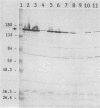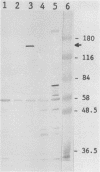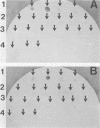Abstract
We examined Bordetella avium for virulence factors common to Bordetella pertussis, including pertussis toxin, filamentous hemagglutinin, adenylate cyclase, dermonecrotic toxin, and tracheal cytotoxin. B. avium produced a dermonecrotic toxin and a tracheal cytotoxin. The dermonecrotic toxin of B. avium is a 155,000-molecular-weight, heat-labile protein which was lethal for mice, guinea pigs, young chickens, and turkey poults and produced dermonecrosis when injected intradermally into guinea pigs, chickens, and turkey poults. High-pressure liquid chromatography of B. avium culture supernatant fluid revealed the presence of a tracheal cytotoxin chemically identical to that produced by B. pertussis. B. avium isolates were negative for B. pertussis-like filamentous hemagglutinin and pertussis toxin when assayed with antibody against B. pertussis filamentous hemagglutinin and pertussis toxin. Furthermore, B. avium failed to induce the clustered CHO cell morphology characteristic of pertussis toxin. Adenylate cyclase assays indicated that B. avium does not produce an extracytoplasmic adenylate cyclase, even after passage through embryonated turkey eggs. Since production of virulence proteins by B. pertussis is regulated by growth in media containing nicotinamide or MgSO4 or by growth at reduced temperatures, we determined the effect of these supplements and growth conditions on production of dermonecrotic toxin by B. avium. Production of dermonecrotic toxin in B. avium was not altered by growth in media containing 100 microM FeSO4 or 500 micrograms of nicotinamide per ml or by growth at 25 or 42 degrees C, but production was significantly decreased by growth in media containing 20 mM MgSO4 and slightly reduced by growth in media containing 500 micrograms of nicotinic acid per ml. These studies revealed that B. avium is similar to B. pertussis in that both species produce a dermonecrotic toxin and a tracheal cytotoxin and production of dermonecrotic toxin is regulated by nicotinamide and MgSO4. The presence of dermonecrotic toxin and tracheal cytotoxin in all Bordetella species indicates that these products may be important virulence factors in bordetellosis.
Full text
PDF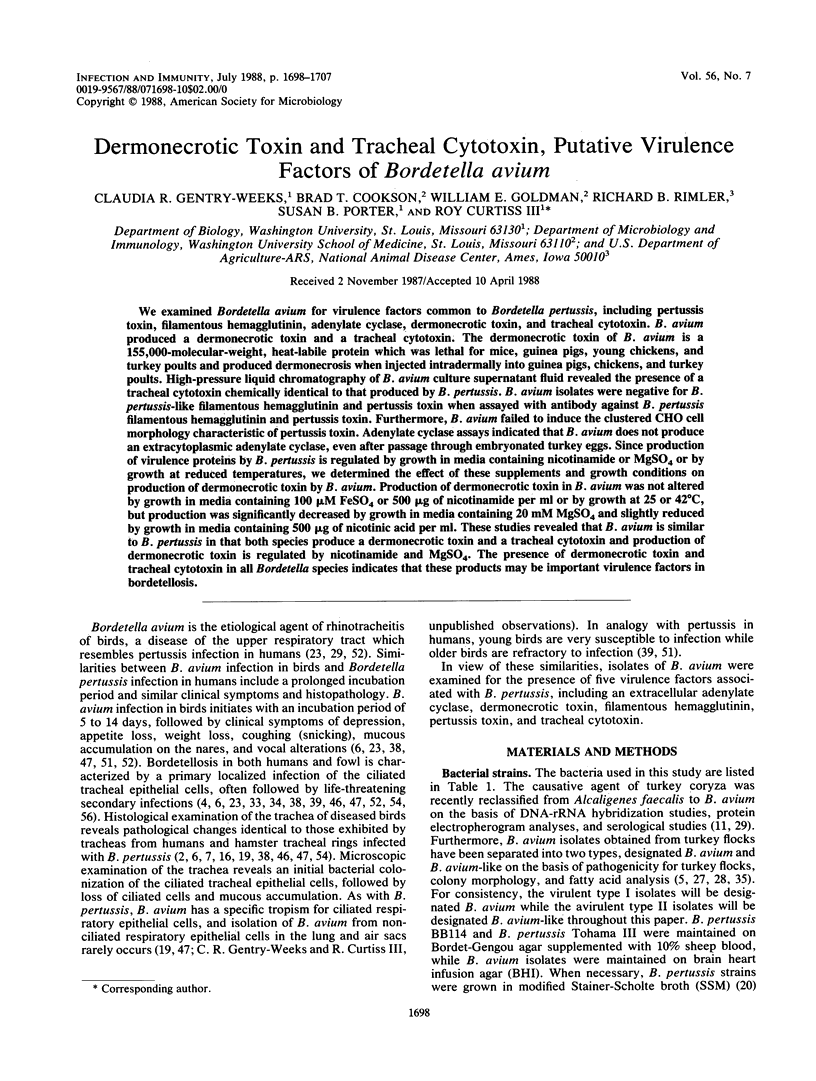
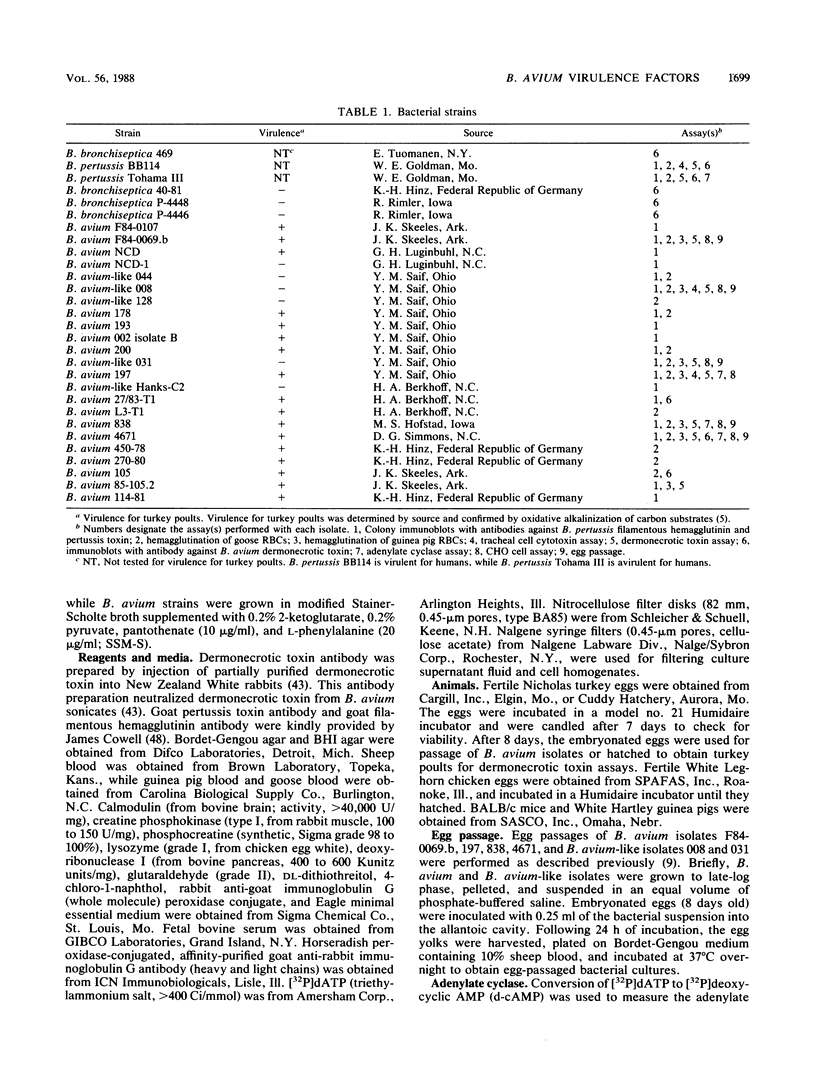
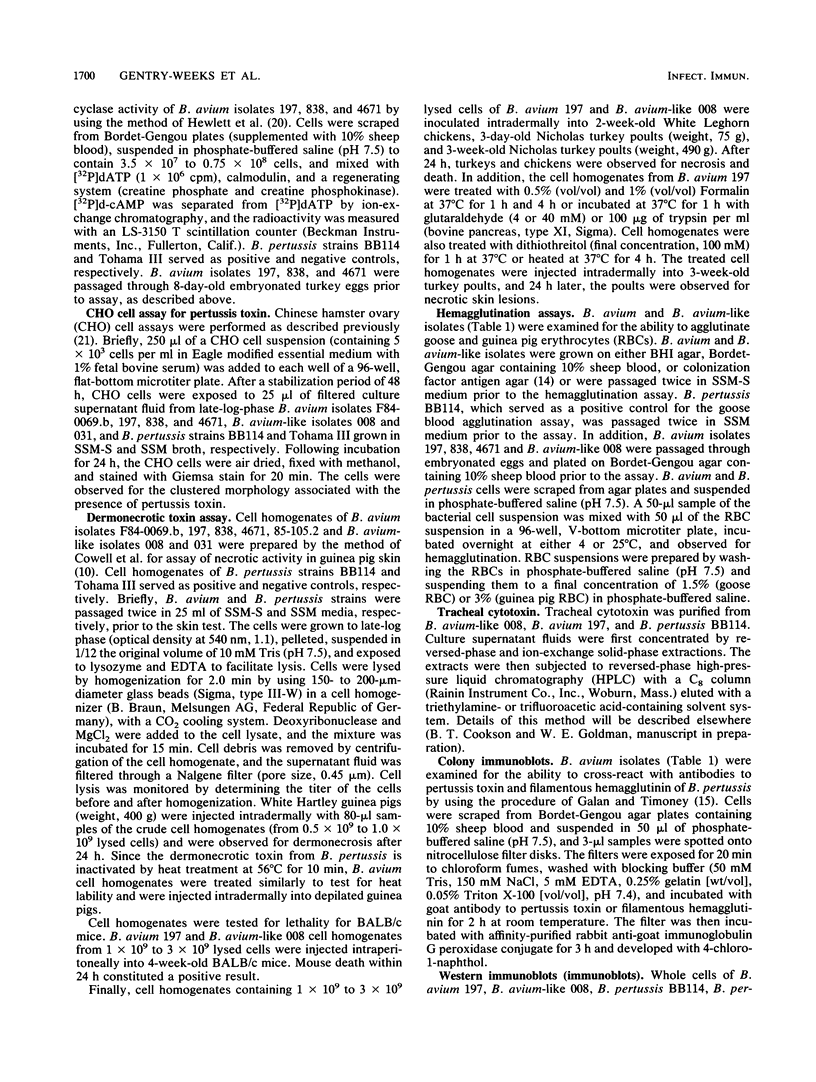
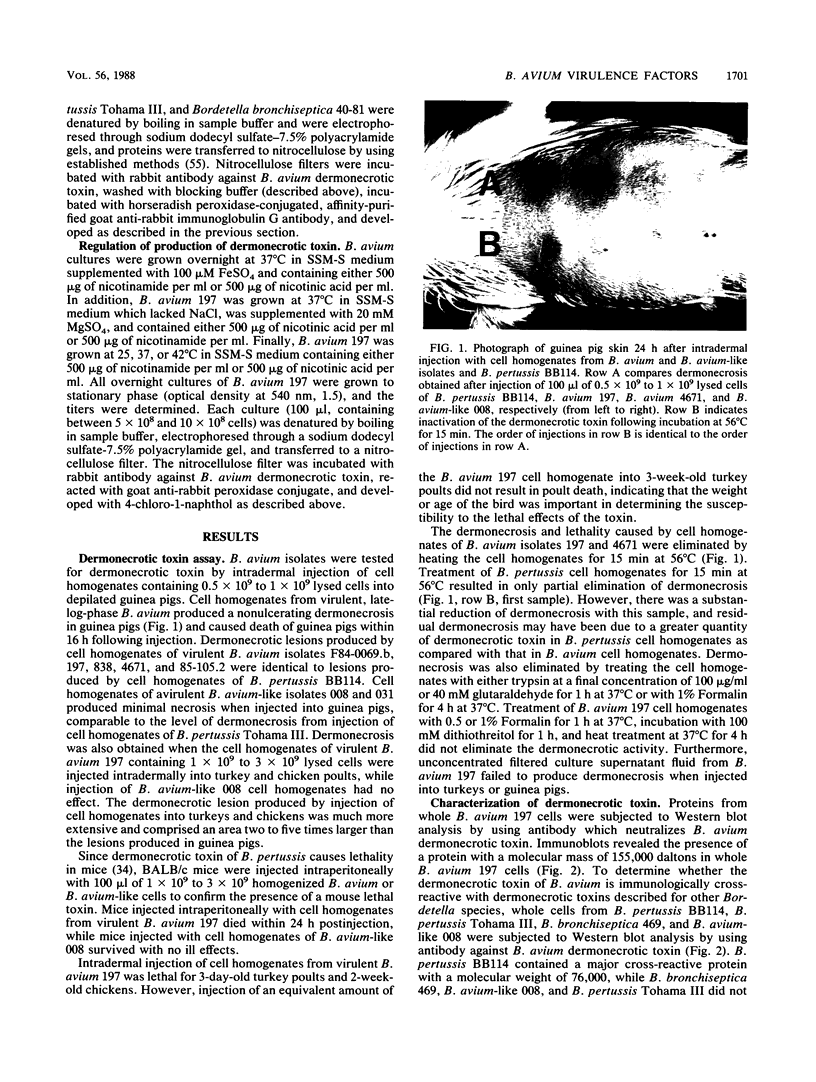
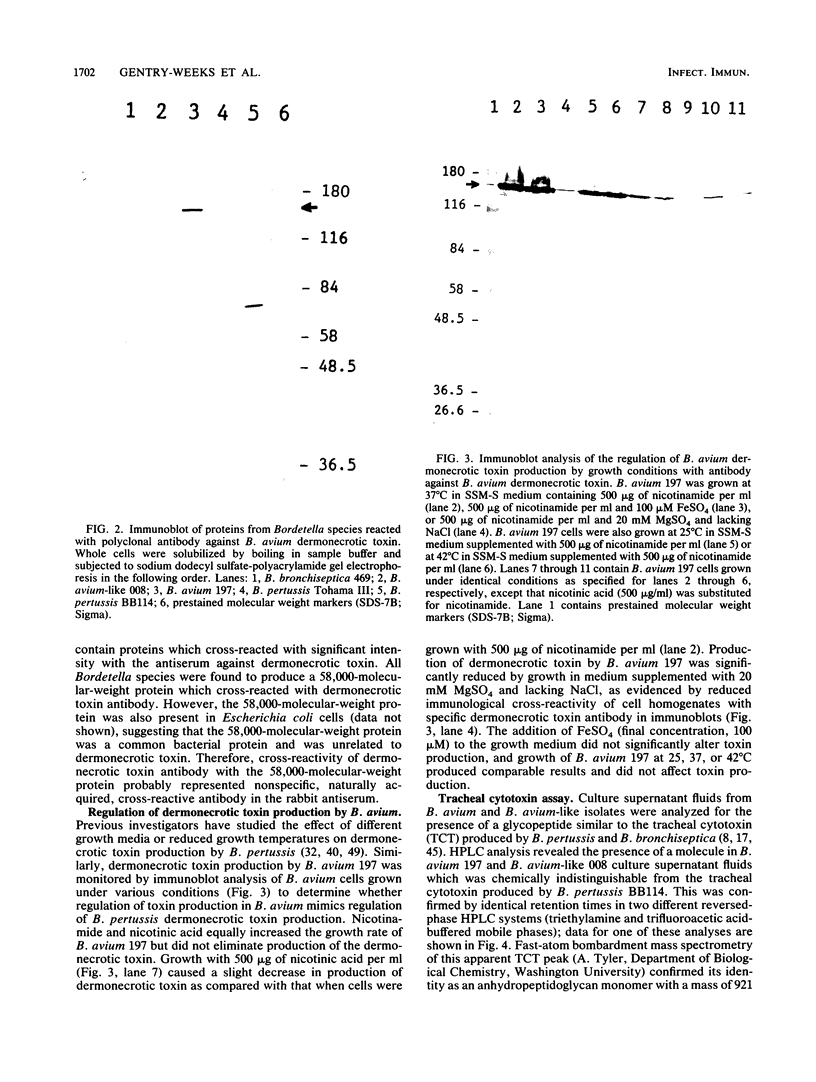


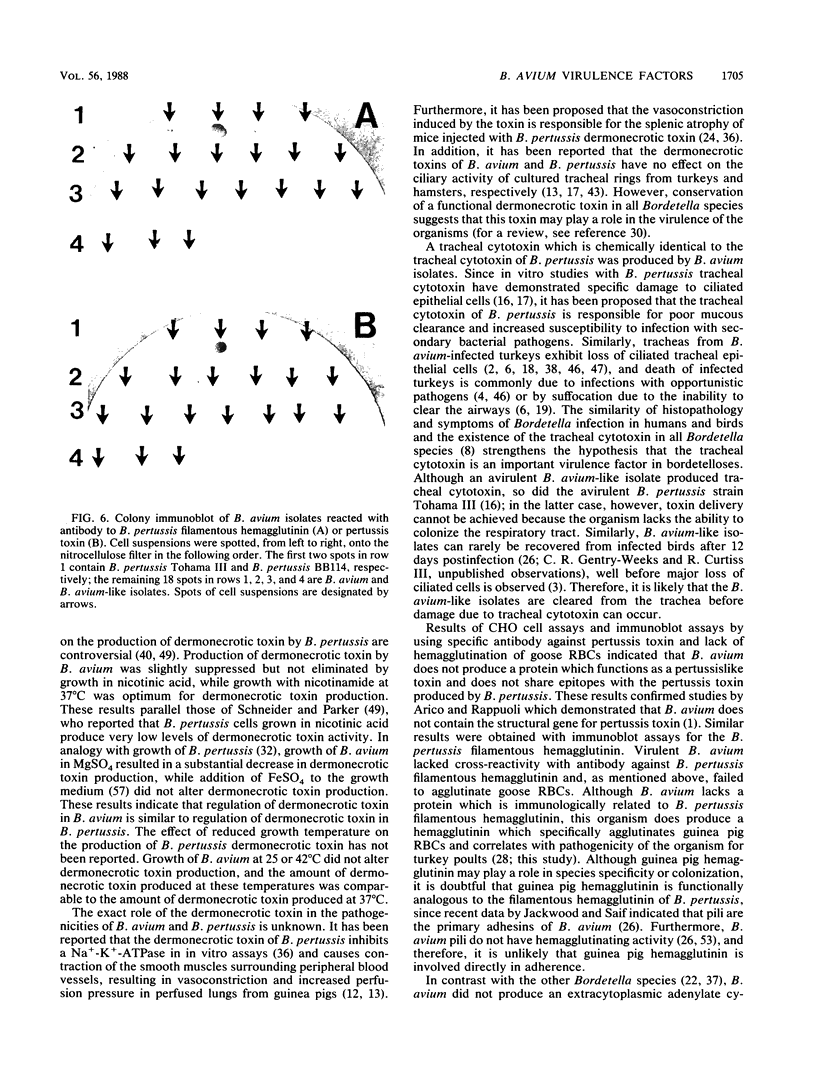
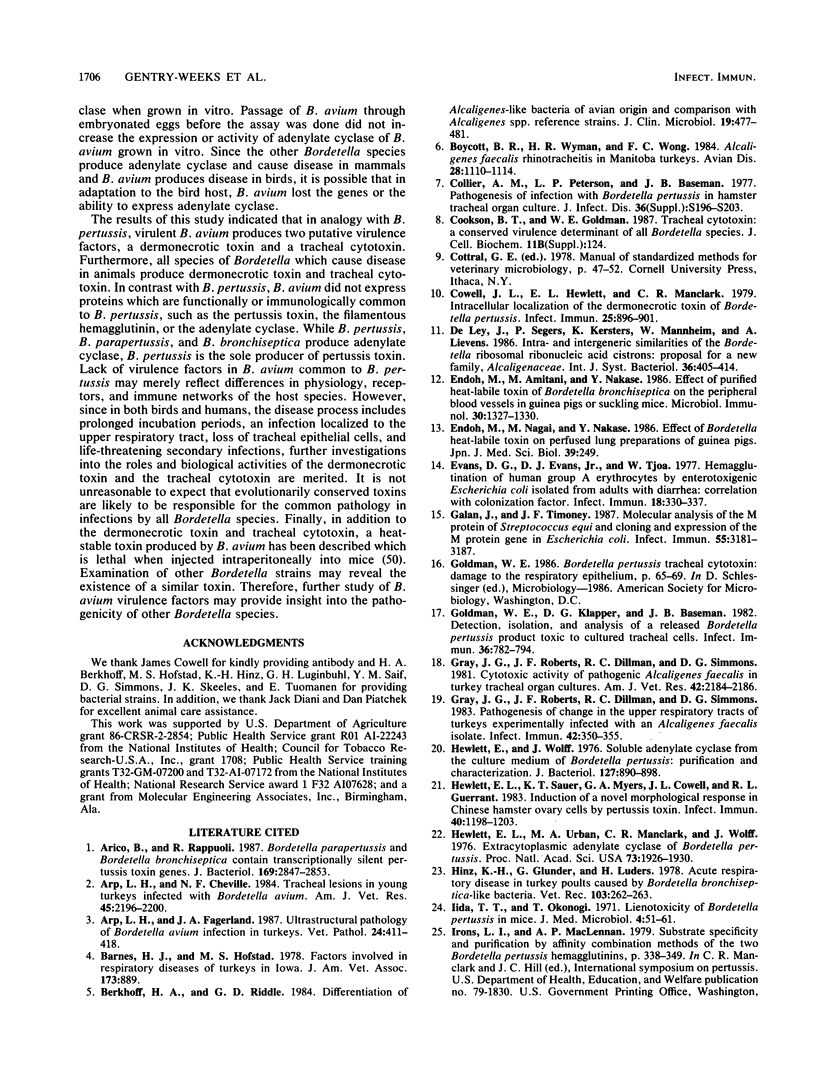
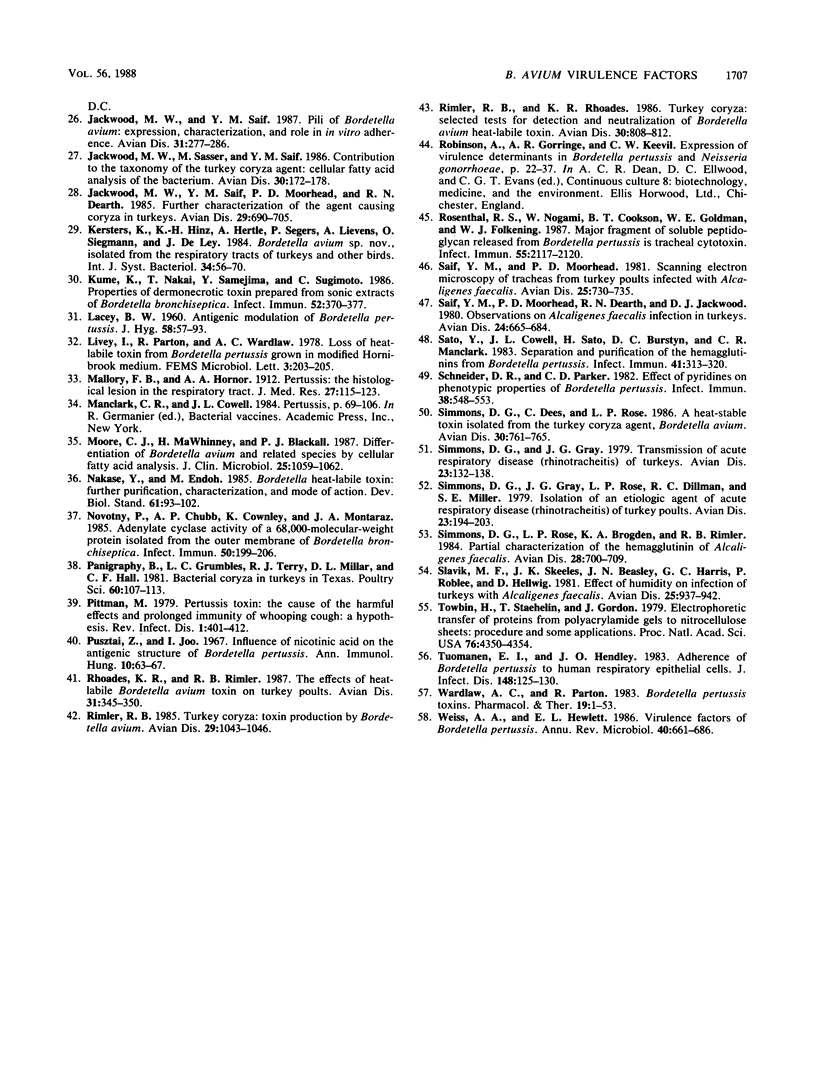
Images in this article
Selected References
These references are in PubMed. This may not be the complete list of references from this article.
- Aricò B., Rappuoli R. Bordetella parapertussis and Bordetella bronchiseptica contain transcriptionally silent pertussis toxin genes. J Bacteriol. 1987 Jun;169(6):2847–2853. doi: 10.1128/jb.169.6.2847-2853.1987. [DOI] [PMC free article] [PubMed] [Google Scholar]
- Arp L. H., Cheville N. F. Tracheal lesions in young turkeys infected with Bordetella avium. Am J Vet Res. 1984 Oct;45(10):2196–2200. [PubMed] [Google Scholar]
- Arp L. H., Fagerland J. A. Ultrastructural pathology of Bordetella avium infection in turkeys. Vet Pathol. 1987 Sep;24(5):411–418. doi: 10.1177/030098588702400508. [DOI] [PubMed] [Google Scholar]
- Berkhoff H. A., Riddle G. D. Differentiation of Alcaligenes-like bacteria of avian origin and comparison with Alcaligenes spp. reference strains. J Clin Microbiol. 1984 Apr;19(4):477–481. doi: 10.1128/jcm.19.4.477-481.1984. [DOI] [PMC free article] [PubMed] [Google Scholar]
- Boycott B. R., Wyman H. R., Wong F. C. Alcaligenes faecalis rhinotracheitis in Manitoba turkeys. Avian Dis. 1984 Oct-Dec;28(4):1110–1114. [PubMed] [Google Scholar]
- Collier A. M., Peterson L. P., Baseman J. B. Pathogenesis of infection with Bordetella pertussis in hamster tracheal organ culture. J Infect Dis. 1977 Aug;136 (Suppl):S196–S203. doi: 10.1093/infdis/136.supplement.s196. [DOI] [PubMed] [Google Scholar]
- Cowell J. L., Hewlett E. L., Manclark C. R. Intracellular localization of the dermonecrotic toxin of Bordetella pertussis. Infect Immun. 1979 Sep;25(3):896–901. doi: 10.1128/iai.25.3.896-901.1979. [DOI] [PMC free article] [PubMed] [Google Scholar]
- Endoh M., Amitani M., Nakase Y. Effect of purified heat-labile toxin of Bordetella bronchiseptica on the peripheral blood vessels in guinea pigs or suckling mice. Microbiol Immunol. 1986;30(12):1327–1330. doi: 10.1111/j.1348-0421.1986.tb03054.x. [DOI] [PubMed] [Google Scholar]
- Evans D. G., Evans D. J., Jr, Tjoa W. Hemagglutination of human group A erythrocytes by enterotoxigenic Escherichia coli isolated from adults with diarrhea: correlation with colonization factor. Infect Immun. 1977 Nov;18(2):330–337. doi: 10.1128/iai.18.2.330-337.1977. [DOI] [PMC free article] [PubMed] [Google Scholar]
- Galán J. E., Timoney J. F. Molecular analysis of the M protein of Streptococcus equi and cloning and expression of the M protein gene in Escherichia coli. Infect Immun. 1987 Dec;55(12):3181–3187. doi: 10.1128/iai.55.12.3181-3187.1987. [DOI] [PMC free article] [PubMed] [Google Scholar]
- Goldman W. E., Klapper D. G., Baseman J. B. Detection, isolation, and analysis of a released Bordetella pertussis product toxic to cultured tracheal cells. Infect Immun. 1982 May;36(2):782–794. doi: 10.1128/iai.36.2.782-794.1982. [DOI] [PMC free article] [PubMed] [Google Scholar]
- Gray J. G., Roberts J. F., Dillman R. C., Simmons D. G. Cytotoxic activity of pathogenic Alcaligenes faecalis in turkey tracheal organ cultures. Am J Vet Res. 1981 Dec;42(12):2184–2186. [PubMed] [Google Scholar]
- Gray J. G., Roberts J. F., Dillman R. C., Simmons D. G. Pathogenesis of change in the upper respiratory tracts of turkeys experimentally infected with an Alcaligenes faecalis isolate. Infect Immun. 1983 Oct;42(1):350–355. doi: 10.1128/iai.42.1.350-355.1983. [DOI] [PMC free article] [PubMed] [Google Scholar]
- Hewlett E. L., Sauer K. T., Myers G. A., Cowell J. L., Guerrant R. L. Induction of a novel morphological response in Chinese hamster ovary cells by pertussis toxin. Infect Immun. 1983 Jun;40(3):1198–1203. doi: 10.1128/iai.40.3.1198-1203.1983. [DOI] [PMC free article] [PubMed] [Google Scholar]
- Hewlett E. L., Urban M. A., Manclark C. R., Wolff J. Extracytoplasmic adenylate cyclase of Bordetella pertussis. Proc Natl Acad Sci U S A. 1976 Jun;73(6):1926–1930. doi: 10.1073/pnas.73.6.1926. [DOI] [PMC free article] [PubMed] [Google Scholar]
- Hewlett E., Wolff J. Soluble adenylate cyclase from the culture medium of Bordetella pertussis: purification and characterization. J Bacteriol. 1976 Aug;127(2):890–898. doi: 10.1128/jb.127.2.890-898.1976. [DOI] [PMC free article] [PubMed] [Google Scholar]
- Hinz K. H., Glünder G., Lüders H. Acute respiratory disease in turkey poults caused by Bordetella bronchiseptica-like bacteria. Vet Rec. 1978 Sep 16;103(12):262–263. doi: 10.1136/vr.103.12.262. [DOI] [PubMed] [Google Scholar]
- Iida T., Okonogi T. Lienotoxicity of Bordetella pertussis in mice. J Med Microbiol. 1971 Feb;4(1):51–61. doi: 10.1099/00222615-4-1-51. [DOI] [PubMed] [Google Scholar]
- Jackwood M. W., Saif Y. M., Moorhead P. D., Dearth R. N. Further characterization of the agent causing coryza in turkeys. Avian Dis. 1985 Jul-Sep;29(3):690–705. [PubMed] [Google Scholar]
- Jackwood M. W., Saif Y. M. Pili of Bordetella avium: expression, characterization, and role in in vitro adherence. Avian Dis. 1987 Apr-Jun;31(2):277–286. [PubMed] [Google Scholar]
- Jackwood M. W., Sasser M., Saif Y. M. Contribution to the taxonomy of the turkey coryza agent: cellular fatty acid analysis of the bacterium. Avian Dis. 1986 Jan-Mar;30(1):172–178. [PubMed] [Google Scholar]
- Kume K., Nakai T., Samejima Y., Sugimoto C. Properties of dermonecrotic toxin prepared from sonic extracts Bordetella bronchiseptica. Infect Immun. 1986 May;52(2):370–377. doi: 10.1128/iai.52.2.370-377.1986. [DOI] [PMC free article] [PubMed] [Google Scholar]
- LACEY B. W. Antigenic modulation of Bordetella pertussis. J Hyg (Lond) 1960 Mar;58:57–93. doi: 10.1017/s0022172400038134. [DOI] [PMC free article] [PubMed] [Google Scholar]
- Moore C. J., Mawhinney H., Blackall P. J. Differentiation of Bordetella avium and related species by cellular fatty acid analysis. J Clin Microbiol. 1987 Jun;25(6):1059–1062. doi: 10.1128/jcm.25.6.1059-1062.1987. [DOI] [PMC free article] [PubMed] [Google Scholar]
- Nakase Y., Endoh M. Bordetella heat-labile toxin: further purification, characterization and mode of action. Dev Biol Stand. 1985;61:93–102. [PubMed] [Google Scholar]
- Novotny P., Chubb A. P., Cownley K., Montaraz J. A. Adenylate cyclase activity of a 68,000-molecular-weight protein isolated from the outer membrane of Bordetella bronchiseptica. Infect Immun. 1985 Oct;50(1):199–206. doi: 10.1128/iai.50.1.199-206.1985. [DOI] [PMC free article] [PubMed] [Google Scholar]
- Panigrahy B., Grumbles L. C., Terry R. J., Millar D. L., Hall C. F. Bacterial coryza in turkeys in Texas. Poult Sci. 1981 Jan;60(1):107–113. doi: 10.3382/ps.0600107. [DOI] [PubMed] [Google Scholar]
- Pittman M. Pertussis toxin: the cause of the harmful effects and prolonged immunity of whooping cough. A hypothesis. Rev Infect Dis. 1979 May-Jun;1(3):401–412. doi: 10.1093/clinids/1.3.401. [DOI] [PubMed] [Google Scholar]
- Rhoades K. R., Rimler R. B. The effects of heat-labile Bordetella avium toxin on turkey poults. Avian Dis. 1987 Apr-Jun;31(2):345–350. [PubMed] [Google Scholar]
- Rimler R. B., Rhoades K. R. Turkey coryza: selected tests for detection and neutralization of Bordetella avium heat-labile toxin. Avian Dis. 1986 Oct-Dec;30(4):808–812. [PubMed] [Google Scholar]
- Rimler R. B. Turkey coryza: toxin production by Bordetella avium. Avian Dis. 1985 Oct-Dec;29(4):1043–1047. [PubMed] [Google Scholar]
- Rosenthal R. S., Nogami W., Cookson B. T., Goldman W. E., Folkening W. J. Major fragment of soluble peptidoglycan released from growing Bordetella pertussis is tracheal cytotoxin. Infect Immun. 1987 Sep;55(9):2117–2120. doi: 10.1128/iai.55.9.2117-2120.1987. [DOI] [PMC free article] [PubMed] [Google Scholar]
- Saif Y. M., Moorhead P. D., Dearth R. N., Jackwood D. J. Observations on Alcaligenes faecalis infection in turkeys. Avian Dis. 1980 Jul-Sep;24(3):665–684. [PubMed] [Google Scholar]
- Saif Y. M., Moorhead P. D., Whitmoyer R. E. Scanning electron microscopy of tracheas from turkey poults infected with Alcaligenes faecalis. Avian Dis. 1981 Jul-Sep;25(3):730–735. [PubMed] [Google Scholar]
- Sato Y., Cowell J. L., Sato H., Burstyn D. G., Manclark C. R. Separation and purification of the hemagglutinins from Bordetella pertussis. Infect Immun. 1983 Jul;41(1):313–320. doi: 10.1128/iai.41.1.313-320.1983. [DOI] [PMC free article] [PubMed] [Google Scholar]
- Schneider D. R., Parker C. D. Effect of pyridines on phenotypic properties of Bordetella pertussis. Infect Immun. 1982 Nov;38(2):548–553. doi: 10.1128/iai.38.2.548-553.1982. [DOI] [PMC free article] [PubMed] [Google Scholar]
- Simmons D. G., Dees C., Rose L. P. A heat-stable toxin isolated from the turkey coryza agent, Bordetella avium. Avian Dis. 1986 Oct-Dec;30(4):761–765. [PubMed] [Google Scholar]
- Simmons D. G., Gray J. G., Rose L. P., Dillman R. C., Miller S. E. Isolation of an etiologic agent of acute respiratory disease (rhinotracheitis) of turkey poults. Avian Dis. 1979 Jan-Mar;23(1):194–203. [PubMed] [Google Scholar]
- Simmons D. G., Gray J. G. Transmission of acute respiratory disease (rhinotracheitis) of turkeys. Avian Dis. 1979 Jan-Mar;23(1):132–138. [PubMed] [Google Scholar]
- Simmons D. G., Rose L. P., Brogden K. A., Rimler R. B. Partial characterization of the hemagglutinin of Alcaligenes faecalis. Avian Dis. 1984 Jul-Sep;28(3):700–709. [PubMed] [Google Scholar]
- Slavik M. F., Skeeles J. K., Beasley J. N., Harris G. C., Roblee P., Hellwig D. Effect of humidity on infection of turkeys with Alcaligenes faecalis. Avian Dis. 1981 Oct-Dec;25(4):936–942. [PubMed] [Google Scholar]
- Towbin H., Staehelin T., Gordon J. Electrophoretic transfer of proteins from polyacrylamide gels to nitrocellulose sheets: procedure and some applications. Proc Natl Acad Sci U S A. 1979 Sep;76(9):4350–4354. doi: 10.1073/pnas.76.9.4350. [DOI] [PMC free article] [PubMed] [Google Scholar]
- Tuomanen E. I., Hendley J. O. Adherence of Bordetella pertussis to human respiratory epithelial cells. J Infect Dis. 1983 Jul;148(1):125–130. doi: 10.1093/infdis/148.1.125. [DOI] [PubMed] [Google Scholar]
- Wardlaw A. C., Parton R. Bordetella pertussis toxins. Pharmacol Ther. 1982;19(1):1–53. doi: 10.1016/0163-7258(82)90041-9. [DOI] [PubMed] [Google Scholar]
- Weiss A. A., Hewlett E. L. Virulence factors of Bordetella pertussis. Annu Rev Microbiol. 1986;40:661–686. doi: 10.1146/annurev.mi.40.100186.003305. [DOI] [PubMed] [Google Scholar]




